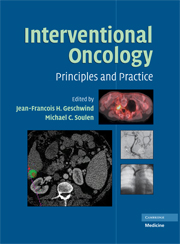Book contents
- Frontmatter
- Contents
- FOREWORD
- ACKNOWLEDGMENTS
- CONTRIBUTORS
- PART I PRINCIPLES OF ONCOLOGY
- PART II PRINCIPLES OF IMAGE-GUIDED THERAPIES
- 5 Image-guided Interventions: Fundamentals of Radiofrequency Tumor Ablation
- 6 Principles of Embolization
- 7 Imaging in Interventional Oncology: Role of Image Guidance
- 8 Assessment of Tumor Response on Magnetic Resonance Imaging after Locoregional Therapy
- PART III ORGAN-SPECIFIC CANCERS
- PART IV SPECIALIZED INTERVENTIONAL TECHNIQUES IN CANCER CARE
- INDEX
- Plate section
- References
7 - Imaging in Interventional Oncology: Role of Image Guidance
from PART II - PRINCIPLES OF IMAGE-GUIDED THERAPIES
Published online by Cambridge University Press: 18 May 2010
- Frontmatter
- Contents
- FOREWORD
- ACKNOWLEDGMENTS
- CONTRIBUTORS
- PART I PRINCIPLES OF ONCOLOGY
- PART II PRINCIPLES OF IMAGE-GUIDED THERAPIES
- 5 Image-guided Interventions: Fundamentals of Radiofrequency Tumor Ablation
- 6 Principles of Embolization
- 7 Imaging in Interventional Oncology: Role of Image Guidance
- 8 Assessment of Tumor Response on Magnetic Resonance Imaging after Locoregional Therapy
- PART III ORGAN-SPECIFIC CANCERS
- PART IV SPECIALIZED INTERVENTIONAL TECHNIQUES IN CANCER CARE
- INDEX
- Plate section
- References
Summary
Advances in medical imaging have created the opportunity for minimally invasive, image-guided oncologic care. Through the 1980s and 1990s, as diagnostic scan quality improved, it became obvious to make the transition from using imaging tools simply for diagnostic use to roles that could aid in intervention. As an interventional tool, medical imaging allows visualization of anatomic targets inside the body without requiring direct, open surgical visualization. When combined with advances in medical device design and device miniaturization, medical imaging can guide devices to targets for therapy without large incisions. These less invasive, image-guided procedures offer patients an opportunity for faster, less complicated recoveries.
Interventional use of imaging equipment has different priorities compared with diagnostic uses of imaging equipment. In general, generating the highest quality image is most important for diagnosis. This means that taking more imaging time or applying more radiation are acceptable “costs” for diagnostic imaging. In contrast, patients come to interventional procedures already having undergone high-quality diagnostic imaging. For interventional procedures, in general, lower-quality imaging is an acceptable compromise for real-time imaging with lower radiation dose. Interventional procedures, therefore, prioritize imaging equipment that (1) provides real-time imaging, (2) lowers radiation dose and (3) provides greater physician access to the patient. Although most current image-guided therapy still utilizes standard diagnostic imaging equipment, more and more imaging equipment is being customized for the particular needs of interventional procedures. These future intervention-focused improvements will help broaden the applications of image-guided therapy.
- Type
- Chapter
- Information
- Interventional OncologyPrinciples and Practice, pp. 78 - 85Publisher: Cambridge University PressPrint publication year: 2008



